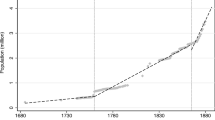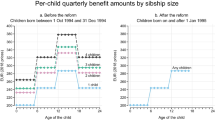Abstract
Parsons and Goldin (in Econ Inq 637–659, 1989) use the US Commissioner of Labor Survey of (1890) to argue that many American parents sacrificed the future earnings of their children by sending them to work rather than to school. We analyze the same data and argue that parental choices were dictated by constraints rather than the desire to exploit child labor opportunities. We also find significant income effects on child labor supply, indicating that affluence played an important part in the decline of child labor. The coexistence of positive assets with child labor is not inconsistent with parental altruism, indicating instead a failure of perfect two-sided altruism.
Similar content being viewed by others
Notes
Goldin and Sokoloff (1982) show that in the first half of the nineteenth century, child work was widespread in agriculture and artisanal production. Within manufacturing industry, cotton and woollen textiles were the main users of child labor. Children constituted 50% of the workforce in cotton textiles, and 41% of the workforce in woolen textiles (among firms employing 16 or more workers).
It is straightforward to generalize these arguments to families with several children or adults.
For example, Goldin and Katz (2008) use the 1915 Iowa census and find that the rates of return to education for men were between 10 and 12%.
Note that PG assume that there is no other source of compensating differentials, apart from child labor opportunities. To the extent that jobs varied in other non-pecuniary characteristics, such as working conditions, the estimated coefficient would also capture this term.
Twenty five percent of the children of unskilled workers in woolen textiles were employed.
As we have noted before, there could be other sources of compensating differentials, such as unpleasant working conditions. These seem plausibly to be less important than skill barriers to entry, given the magnitude of the wage gains from re-employment in high-wage industries.
Their estimates of employment probability by age and sex are obtained by regressing the number of children working upon age and gender composition of the family.
The efficiency wage model has the same qualitative empirical predictions—for industries where child labor can be employed, the required efficiency wage would be lower for families with boys as compared to families with girls, and thus, the former would be employed preferentially, thereby biasing sex ratios across locations.
We are grateful to an anonymous referee for bringing this evidence to our attention.
However, Ray (2000) analyses data from Pakistan and Peru and finds mixed results, with weak income effects in Pakistan.
This is consistent with the evidence—in 1850, the median age at which children left home was 22.5 for males and 20.5 for females (see Whaples 2005).
Although the coefficients are somewhat different in the two specifications, this difference is offset by the difference in the proportion of uncensored observations. As a result, the marginal effect is 0.086 in the first specification and 0.088 in the second.
Following Baland and Robinson, this assumes that the child’s consumption is fixed and does not depend upon the child labor decision. Moehling (2005) presents evidence showing that the consumption of children rose with their labor force participation.
Indeed, if parents are altruistic, then the public provision of old-age insurance or pensions would be sufficient to induce efficient child labor decisions.
For girls, the own-wage elasticity is not significantly different from zero.
References
Baland J-M, Robinson J (2000) Is child labor inefficient? J Political Econ 102:663–679
Banerjee A, Mullainathan S (2010) The shape of temptation: implications for the economic lives of the poor. Mimeo
Basu K, Van P (1998) The economics of child labor. Am Econ Rev 88:412–427
Becker G, Murphy K (1988) The family and the state. J Law Econ 31(1):1–18
Beegle K, Dehejia R, Gatti R (2006) Child labor and agricultural shocks. J Dev Econ 81(1):80–96
Bhalotra S (2007) Is child work necessary? Oxf Bull Econ Stat 69(1):29–55
Bliss C, Stern N (1978) Productivity, wages and nutrition, Part I: the theory. J Dev Econ 5:331-362
Cunningham H (2000) The decline of child labour: labour markets and family economies in Europe and North America since 1830. Econ Hist Rev 23:409–428
Dasgupta P, Ray D (1987) Inequality as a determinant of malnutrition and unemployment: theory. Econ J 97:1011–1034
Edmonds E (2006) Child labor and schooling responses to anticipated income in South Africa. J Dev Econ 81(2):386–414
Fishback PV (1992) Soft coal, hard choices: the economic welfare of bituminous coal miners, 1890–1930. Oxford University Press, New York
Genicot G (2005) Malnutrition and child labor. Scand J Econ 107(1):83–102
Goldin C (1979) Household and market production of families in a late nineteenth century American City. Explor Econ Hist 16:111–131
Goldin C, Katz L (2008) The race between education and technology. Harvard University Press, Cambridge
Goldin C, Sokoloff K (1982) Women, children and industrialization in the early republic: evidence from the manufacturing censuses. J Econ Hist 42(4):741–774
Goodrich C (1925) The Miner’s freedom: a study of the working life in a changing industry. Marshall Jones Company, Boston
Leibenstein H (1957) Economic backwardness and economic growth. Wiley, New York
Lleras-Muney A (2002) Were compulsory attendance and child labor laws effective? An analysis from 1915 to 1939. J Law Econ 45(2):401–435
Haines MR (1979) Industrial work and the family life cycle, 1889–1890. Res Econ Hist 4:289–356
Horrell S, Humphries J (1995) The exploitation of little children: child labour and family economy in the industrial revolution. Explor Econ Hist 32(4):485–516
Marx K (1867) Capital, Vol I, Reprinted 1971. Lawrence & Wishart, London
Mincer J (1978) Family migration decisions. J Political Econ 5:331–3
Moehling C (1999) State child labor laws and the decline of child labour. Explor Econ Hist 36:72–106
Moehling C (2005) ‘Suddenly she has become powerful’: youth employment and household decision-making in the early twentieth century. J Econ Hist 65 (2):414–438
Manacorda M (2006) Child labour and the labour supply of other household members: evidence from 1920 America. Am Econ Rev 96(5):1788–1801
Nardinelli (1980) Child labour and the factory acts. J Econ Hist 40(4):739–755
Parsons DO, Goldin C (1989) Parental altruism and self-interest: child labor among late nineteenth-century American families. Econ Inq 27(4):637–659
Ray R (2000) Analysis of child labor in Peru and Pakistan: a comparative study. J Popul Econ 13:3–19
Ranjan P (2001) Credit constraints and the phenomenon of child labor. J Dev Econ 64(1):81–102
US Commissioner of Labor (1890) Sixth annual report of the commissioner of labor 1890, Part III: cost of living, House of Representatives, House Executive Document 265, 51st Congress, Washington: Government Printing Office
Whaples R (2005) Child labor in the United States. EHnet Encyclopedia
Acknowledgments
We are very grateful to Michael Haines for providing us with the data used in the paper, and to Marco Francesconi, Carolyn Moehling, an anonymous referee, and various seminar participants for their comments and suggestions.
Author information
Authors and Affiliations
Corresponding author
Rights and permissions
About this article
Cite this article
Bhaskar, V., Gupta, B. Parental altruism and child labor: examining the historical evidence from the United States. Cliometrica 6, 249–266 (2012). https://doi.org/10.1007/s11698-012-0077-8
Received:
Accepted:
Published:
Issue Date:
DOI: https://doi.org/10.1007/s11698-012-0077-8




